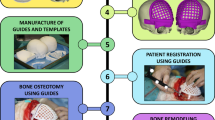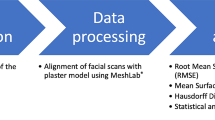Abstract
Purpose
Surgical correction of metopic craniosynostosis typically involves open cranial vault remodeling. Accurate translation of the virtual surgical plan into the operating room is challenging due to the lack of tools for intraoperative analysis of the surgical outcome. This study aimed to evaluate the feasibility of using a hand-held 3D photography device for intraoperative evaluation and guidance during cranial vault surgical reconstruction.
Methods
A hand-held structured light scanner was used for intraoperative 3D photography during five craniosynostosis surgeries, obtaining 3D models of skin and bone surfaces before and after the remodeling. The accuracy of this device for 3D modeling and morphology quantification was evaluated using preoperative computed tomography imaging as gold-standard. In addition, the time required for intraoperative 3D photograph acquisition was measured.
Results
The average error of intraoperative 3D photography was 0.30 mm. Moreover, the interfrontal angle and the transverse forehead width were accurately measured in the 3D photographs with an average error of 0.72 degrees and 0.62 mm. Surgeon’s feedback indicates that this technology can be integrated into the surgical workflow without substantially increasing surgical time.
Conclusion
Hand-held 3D photography is an accurate technique for objective quantification of intraoperative cranial vault morphology and guidance during metopic craniosynostosis surgical reconstruction. This noninvasive technique does not substantially increase surgical time and does not require exposure to ionizing radiation, presenting a valuable alternative to computed tomography imaging. The proposed methodology can be integrated into the surgical workflow to assist during cranial vault remodeling and ensure optimal surgical outcomes.





Similar content being viewed by others
Availability of data and material
The datasets generated and/or analyzed during the current study are publicly available at https://doi.org/10.6084/m9.figshare.13078925.v1.
References
Van Der Meulen J (2012) Metopic synostosis. Child’s Nerv Syst 28:1359–1367. https://doi.org/10.1007/s00381-012-1803-z
Kweldam CF, Van Der Vlugt JJ, Van Der Meulen JJNM (2011) The incidence of craniosynostosis in the Netherlands, 1997–2007. J Plast Reconstr Aesthetic Surg 64:583–588. https://doi.org/10.1016/j.bjps.2010.08.026
Van Der Meulen J, Van Der Hulst R, Van Adrichem L, Arnaud E, Chin-Shong D, Duncan C, Habets E, Hinojosa J, Mathijssen I, May P, Morritt D, Nishikawa H, Noons P, Richardson D, Wall S, Van Der Vlugt J, Renier D (2009) The increase of metopic synostosis: a pan-European observation. J Craniofac Surg 20:283–286. https://doi.org/10.1097/SCS.0b013e31818436be
Slater BJ, Lenton KA, Kwan MD, Gupta DM, Wan DC, Longaker MT (2008) Cranial sutures: a brief review. Plast Reconstr Surg 121:170–178. https://doi.org/10.1097/01.prs.0000304441.99483.97
Hochfeld M, Lamecker H, Thomale U-W, Schulz M, Zachow S, Haberl H (2014) Frame-based cranial reconstruction. J Neurosurg Pediatr 13:319–323. https://doi.org/10.3171/2013.11.peds1369
Meulstee JW, Verhamme LM, Borstlap WA, Van der Heijden F, De Jong GA, Xi T, Bergé SJ, Delye H, Maal TJJ (2017) A new method for three-dimensional evaluation of the cranial shape and the automatic identification of craniosynostosis using 3D stereophotogrammetry. Int J Oral Maxillofac Surg 46:819–826. https://doi.org/10.1016/j.ijom.2017.03.017
Kellogg R, Allori AC, Rogers GF, Marcus JR (2012) Interfrontal angle for characterization of trigonocephaly: part 1: development and validation of a tool for diagnosis of metopic synostosis. J Craniofac Surg 23:799–804. https://doi.org/10.1097/SCS.0b013e3182518ad2
Ruiz-Correa S, Starr JR, Lin HJ, Kapp-Simon K, Sze RW, Ellenbogen RG, Speltz ML (2008) New severity indices for quantifying single-suture metopic craniosynostosis. Neurosurgery 63:325. https://doi.org/10.1227/01.NEU.0000316417.06500.DA
Mendoza CS, Safdar N, Myers E, Kittisarapong T, Rogers GF, Linguraru MG (2013) An optimal set of landmarks for metopic craniosynostosis diagnosis from shape analysis of pediatric CT scans of the head. Med Imaging Comput Diagnosis 8670:86702T. https://doi.org/10.1117/12.2008039
Wood BC, Mendoza CS, Oh AK, Myers E, Safdar N, Linguraru MG, Rogers GF (2015) What’s in a name? Accurately diagnosing metopic craniosynostosis using a computational approach. Plast Reconstr Surg 137:205–213. https://doi.org/10.1097/PRS.0000000000001938
Kobets AJ, Ammar A, Nakhla J, Scoco A, Nasser R, Goodrich JT, Abbott R (2018) Virtual modeling, stereolithography, and intraoperative CT guidance for the optimization of sagittal synostosis reconstruction: a technical note. Child’s Nerv Syst 34:965–970. https://doi.org/10.1007/s00381-018-3746-5
Schweitzer T, Böhm H, Meyer-Marcotty P, Collmann H, Ernestus RI, Krauß J (2012) Avoiding CT scans in children with single-suture craniosynostosis. Child’s Nerv Syst 28:1077–1082. https://doi.org/10.1007/s00381-012-1721-0
Wong JY, Oh AK, Ohta E, Hunt AT, Rogers GF, Mulliken JB, Deutsch CK (2008) Validity and reliability of craniofacial anthropometric measurement of 3D digital photogrammetric images. Cleft Palate-Craniofacial J 45:232–239. https://doi.org/10.1597/06-175
Wilbrand JF, Szczukowski A, Blecher JC, Pons-Kuehnemann J, Christophis P, Howaldt HP, Schaaf H (2012) Objectification of cranial vault correction for craniosynostosis by three-dimensional photography. J Cranio-Maxillofacial Surg 40:726–730. https://doi.org/10.1016/j.jcms.2012.01.007
Porras AR, Tu L, Tsering D, Mantilla E, Oh A, Enquobahrie A, Keating R, Rogers GF, Linguraru MG (2019) Quantification of head shape from three-dimensional photography for pre- and post-surgical evaluation of craniosynostosis. Plast Reconstr Surg. https://doi.org/10.1097/prs.0000000000006260
Mikolajek M, Machacek Z, Koziorek J (2014) Modern sensor technology for alphanumeric recognition in metallurgy industry. Elektron ir Elektrotechnika. https://doi.org/10.5755/j01.eee.20.5.7090
Allegra D, Gallo G, Inzerillo L, Lombardo M, Milotta FLM, Santagati C, Stanco F (2016) Low cost handheld 3D scanning for architectural elements acquisition. Smart Tools Apps Comput Graph STAG 2016:127–131. https://doi.org/10.2312/stag.20161372
Modabber A, Peters F, Kniha K, Goloborodko E, Ghassemi A, Lethaus B, Hölzle F, Möhlhenrich SC (2016) Evaluation of the accuracy of a mobile and a stationary system for three-dimensional facial scanning. J Cranio-Maxillofacial Surg 44:1719–1724. https://doi.org/10.1016/j.jcms.2016.08.008
Rodriguez-Florez N, Göktekin ÖK, Bruse JL, Borghi A, Angullia F, Knoops PGM, Tenhagen M, O’Hara JL, Koudstaal MJ, Schievano S, Jeelani NUO, James G, Dunaway DJ (2017) Quantifying the effect of corrective surgery for trigonocephaly: a non-invasive, non-ionizing method using three-dimensional handheld scanning and statistical shape modelling. J Cranio-Maxillofacial Surg 45:387–394. https://doi.org/10.1016/j.jcms.2017.01.002
Tenhagen M, Bruse JL, Rodriguez-florez N, Angullia F, Borghi A, Koudstaal MJ, Schievano S, Jeelani O, Dunaway D (2016) Three-dimensional handheld scanning to quantify head-shape changes in spring-assisted surgery for sagittal craniosynostosis. J Craniofac Surg 27:2117–2123. https://doi.org/10.1097/SCS.0000000000003108
García-Vázquez V, Sesé-Lucio B, Calvo FA, Vaquero JJ, Desco M, Pascau J (2018) Surface scanning for 3D dose calculation in intraoperative electron radiation therapy. Radiat Oncol 13:243. https://doi.org/10.1186/s13014-018-1181-0
Mendoza CS, Safdar N, Okada K, Myers E, Rogers GF, Linguraru MG (2014) Personalized assessment of craniosynostosis via statistical shape modeling. Med Image Anal 18:635–646. https://doi.org/10.1016/j.media.2014.02.008
Fedorov A, Beichel R, Kalpathy-Cramer J, Finet J, Fillion-Robin J-C, Pujol S, Bauer C, Jennings D, Fennessy F, Sonka M, Buatti J, Aylward S, Miller JV, Pieper S, Kikinis R (2012) 3D Slicer as an image computing platform for the Quantitative Imaging Network. Magn Reson Imaging 30:1323–1341. https://doi.org/10.1016/J.MRI.2012.05.001
Phillips N (2016) Berry & Kohn’s operating room technique, 13th edn. Elsevier Inc., St. Louis
Besl PJ, McKay ND (1992) A method for registration of 3-D shapes. IEEE Trans Pattern Anal Mach Intell 14:239–256. https://doi.org/10.1109/34.121791
Fearon JA, Ditthakasem K, Chan WNJ, Herbert M (2020) Long-term growth following trigonocephaly repairs: are overcorrections necessary? Plast Reconstr Surg 145:1
García-Mato D, Ochandiano S, García-Sevilla M, Navarro-Cuéllar C, Darriba-Allés JV, García-Leal R, Calvo-Haro JA, Pérez-Mañanes R, Salmerón JI, Pascau J (2019) Craniosynostosis surgery: workflow based on virtual surgical planning, intraoperative navigation and 3D printed patient-specific guides and templates. Sci Rep 9:17691. https://doi.org/10.1038/s41598-019-54148-4
García-Mato D, Moreta-Martínez R, García-Sevilla M, Ochandiano S, García-Leal R, Pérez-Mañanes R, Calvo-Haro JA, Salmerón JI, Pascau J (2020) Augmented reality visualization for craniosynostosis surgery. Comput Methods Biomech Biomed Eng Imaging Vis. https://doi.org/10.1080/21681163.2020.1834876
Martini M, Schulz M, Röhrig A, Nadal J, Messing-Jünger M (2015) A 3D morphometric follow-up analysis after frontoorbital advancement in non-syndromic craniosynostosis. J Cranio-Maxillofacial Surg 43:1428–1437. https://doi.org/10.1016/j.jcms.2015.07.018
Lethaus B, Gruichev D, Gräfe D, Bartella AK, Hahnel S, Yovev T, Pausch NC, Krause M (2020) “Black bone”: the new backbone in CAD/CAM-assisted craniosynostosis surgery? Acta Neurochir (Wien). https://doi.org/10.1007/s00701-020-04445-z
Acknowledgements
The authors would like to thank the surgeons of the Department of Oral and Maxillofacial Surgery and Department of Neurosurgery at Hospital General Universitario Gregorio Marañón for their feedback and help in this study.
Funding
This work was supported by projects PI18/01625 (Ministerio de Ciencia e Innovación, Instituto de Salud Carlos III and European Regional Development Fund “Una manera de hacer Europa”), R42 HD081712 (Eunice Kennedy Shriver National Institute of Child Health and Human Development), and K99DE027993 (National Institute of Dental and Craniofacial Research).
Author information
Authors and Affiliations
Contributions
D.G.M. wrote the main manuscript text and prepared all figures and tables. D.G.M., M.G.S. and A.R.P performed data acquisition and processing. M.G.L. contributed to the design of the workflow for morphological analysis. M.G.S., A.R.P., S.O., M.G.L., and J.P. substantively revised the manuscript text. S.O., J.V.D.A., R.G.L., and J.I.S. helped in the conception and design of the proposed workflow for optimal translation into the clinical practice. All authors reviewed the manuscript.
Corresponding author
Ethics declarations
Conflicts of interest
The authors declare that they have no conflicts of interest.
Ethics approval
The study was approved by the Research Ethics Committee at Hospital General Universitario Gregorio Marañón and performed in accordance with the principles of the 1964 Declaration of Helsinki as revised in 2013.
Informed consent
Informed consents were obtained from the parents or legal guardians.
Additional information
Publisher's Note
Springer Nature remains neutral with regard to jurisdictional claims in published maps and institutional affiliations.
Electronic supplementary material
Below is the link to the electronic supplementary material.
Supplementary material 1 (MP4 38217 kb)
Rights and permissions
About this article
Cite this article
García-Mato, D., García-Sevilla, M., Porras, A.R. et al. Three-dimensional photography for intraoperative morphometric analysis in metopic craniosynostosis surgery. Int J CARS 16, 277–287 (2021). https://doi.org/10.1007/s11548-020-02301-0
Received:
Accepted:
Published:
Issue Date:
DOI: https://doi.org/10.1007/s11548-020-02301-0




